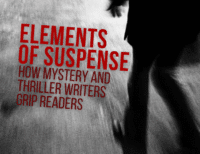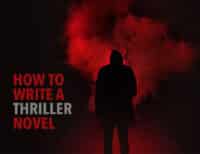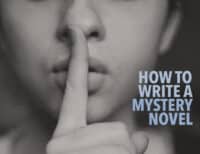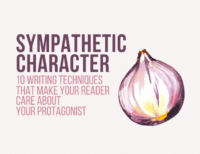You’ve put a lot of time, effort, research, planning, blood, sweat, and tears into finishing your book—and you’re almost there! And then you’re not. You’ve suddenly lost the thread, wandering off into strange paths, with no idea how to end a story, wrap it up and call it done.

If this has ever happened to you, you’re in good company. It’s a common issue among writers, and one I hope to help you solve with a few techniques I learned from my mentor, Dean Wesley Smith.
One book’s ending is another beginning
You’ve probably heard the conventional wisdom that your cover, blurb, and opening lines will sell your book but the ending will sell your next book. It’s true. Think about your own behavior when you reach the end of a book.
If you’re enjoying the story, you’ve probably been making mental notes to look up more books by this author. But if you reach the end and it leaves you disappointed and unfulfilled, that intention might very well go out the window. As readers, we demand satisfaction from an ending. And if we get it, it catapults us into seeking more where that came from.
The wisdom of Ferris Buehler
I’m one of those odd duck readers that devours a book cover to cover. I read the introduction and the table of contents, the notes, the acknowledgments, pretty much everything. And when I go to the movies, I’m the last one to leave the theater. I like to watch the credits, and sometimes there are fun little treats tucked into the end of the movie.
For instance, Ferris Beuhler at the end of his day off telling the audience, “It’s over. Go home.” When you reach the end of your story, your reader should know it’s the end. There should be that feeling of finality, and there are a number of techniques you can use to make sure that happens.
Don’t cheat your reader
When you land upon a great story idea, chances are you’re thinking about some great scenes you could write, a few twists you might throw in, and how you’ll build to that glorious climactic moment. Most of us don’t really think past that. The climax is the culmination of the story. What’s left after that?
Quite a lot, as it turns out.
You owe your reader a resolution. This is especially true when your main character has an internal issue that didn’t resolve during the story’s climax, as is often the case. You need to provide some closure for that inner struggle, tie up loose ends, and maybe most importantly, leave a few dangling threads if you plan to write a sequel.
4 Ways to Resolve Your Story
Ready to wrap it up? Try one or more of these techniques.
1. Take a leap
One of the best-known tricks for signaling the end of a book is a time jump after the climax. Your characters just went through a harrowing, peril-packed, mind-bending experience and someone was injured.
Cut.
The next scene is set two days later, in a hospital room with characters gathered round that someone’s bed to talk out any details that need a wrap and provide some heart-warming moments for readers. And so forth.
Of course, it doesn’t have to be a hospital room and it doesn’t have to be two days. Choose your time and place, but the point is that the characters have moved on, beyond the climactic moment, and the message is that things are getting back to normal. Or maybe there’s no going back. It depends on your theme, but this is the time to let it sink in to your reader.
If you don’t want to jump forward in time, sometimes a scene change will suffice. By placing your characters in a setting apart from where the climax occurred, you signal that the story is coming to an end.
2. A change of pace
Towards the end of a book, the pace picks up, sweeping the reader into the climactic scene. Afterwards, the pace changes, slowing down, allowing the reader and characters to catch their breath. There are pacing tricks you can use—such as sentence length, paragraph length, voice, and so on—to create this altered feeling.
This change of pace allows the reader to prepare, emotionally, for the story’s end, to say her goodbyes to the characters. And if you’ve done it right, making her fall in love with your characters, she won’t want it to be over. She’ll be looking for the next book so she can spend more time with that character she bonded with.
3. A lovely pair of bookends
Readers love a story that comes full circle, tying the ending back to something that happened at the beginning. In order to pull this off, you have to set it up at the beginning. If you’re worried you’re not clever enough to pull this off—stop worrying.
Often, you won’t realize you’re dealing with this type of story until you get to the end. Then, you simply go back to the beginning and weave in the setup. As a writer, you are unstuck in time and can move through your storyline with impunity.
Theme reveals itself to you as you write. You may not grasp the underlying themes of your story until you’ve finished writing it. But that’s great, because you can go back and develop them more fully in earlier scenes, adding richness and symbolism so that the ending really resonates with your reader.
4. Hit the rewind button
Remember the example I used at the beginning of this article? About losing the thread, wandering lost and confused without knowing how to stop or where to end? When this happens, more likely than not you’ve written past your ending. If the whole thing bogs down, back up and take a look.
Chances are, you’ll see the perfect line to end the story.
That's All
And now, I’ve ended this article by wrapping back to the originating idea. Pretty nifty, eh?
How about you? Do you find endings difficult? Do you have a favorite tactic for creating a satisfying ending? Tell us about it in the comments.
PRACTICE
One of the best ways to learn how to write superb endings is to study the masters. Go to your favorite books in your chosen genre and see how the author handled the end. Look for techniques such as time jumps, pacing, and wrapping the story in a theme, beginning to end.
Then go to your work in progress, or a story you’ve already written, and write (or rewrite) the ending scene using a similar pattern. I’m not talking about the climax, but what comes after the climactic scene. Remember, this is practice in learning to master the techniques of a great ending. You don’t have to use this scene in the finished product, but it gives you a chance to hone the necessary skills.
If you don’t have a WIP or finished story, use someone else’s. This is not for publication, but for your own education. Write for fifteen minutes. When you’re finished, post your results in the comments section, and be sure to leave feedback for your fellow writers!







0 Comments
Trackbacks/Pingbacks